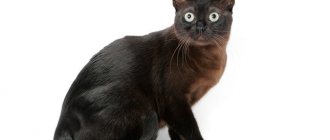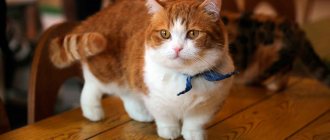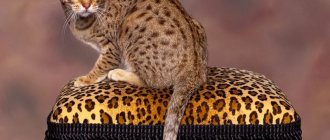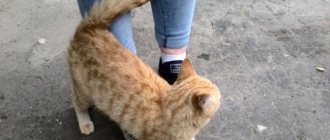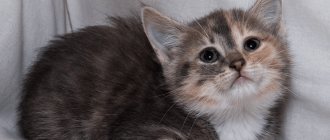Home » Useful Information
Cats have a very delicate mental organization. There are times when using a sleeping pill is the only way to relieve your pet of stress. What drugs are allowed to be used and how to do it correctly?
- 2 How sleeping pills affect your pet’s body
- 3 Types of sleeping pills
3.1 Table: overview of the most popular sleeping pills for cats
3.1.1 Photo gallery: sleeping pills for cats
In what cases can you use sleeping pills for a cat?
Situations when you need to calm your pet are very rare and critical:
- Transportation. Cats do not like sudden changes in environment. Any travel, even regular trips to the doctor, causes extreme stress in these animals. Very active pets can turn a trip into a nightmare for their owners. Others get very sick on the road. To avoid unpleasant situations in transport, it would be better to give your cat a sleeping pill before the trip.
Not all cats can handle travel well; some will do better while asleep.
- Medical manipulations. A visit to the veterinary clinic is an unpleasant adventure. All kinds of manipulations, taking tests and other physical “harassment” irritate the cat and can seriously infuriate it. The best way to freely conduct an examination is to completely immobilize the cat using a sleeping pill.
- Behavior correction and rehabilitation during recovery. Unfortunately, some cats require surgery for medical treatment. The postoperative period is associated with many moments when the cat's mobility must be limited. Also, sleeping pills and potent sedatives are prescribed to overly aggressive, hyperexcitable pets and animals during the heat period.
- Groomer procedures. Show pets or very fluffy domestic cats periodically require visits to cat beauty salons. Of course, when a pet is accustomed to various cosmetic manipulations from infancy, there is no special hassle with beauty restoration. Otherwise, the use of sleeping pills is simply necessary.
When are medications needed?
A sedative is most often used during a visit to the clinic; pets may not always behave calmly when they are being tested, examined, or prepared for surgery. In addition, a kitten needs sedatives if it has severe mental disorders. Calming drops and other forms of medication are necessary for an aggressive cat, a hyperactive pet, or those animals that constantly mark their territory. In addition, medications are given in the following situations:
- during the transportation;
- to eliminate severe stress;
- during the haircut process;
- during surgical interventions;
- to reduce hypersexuality.
How sleeping pills affect your pet's body
Sleeping pills have different durations of action. Conventionally, they can be divided into:
- Short-term. These drugs act for no more than 2–3 hours. They are mainly used during travel or grooming procedures. These remedies greatly relax the animal. The cat may not sleep, but it will allow any liberties with its body. Also, these drugs are great for animals when traveling.
- Medications with an average duration of action. Used when preparing a cat for anesthesia, the presence of convulsive syndrome, and for medicinal purposes. It should be remembered that getting carried away with taking these drugs is fraught with consequences - if they are used frequently, the cat develops a real drug addiction.
- Prolonged (long-term) action agents. It is impossible to find such drugs on the open market, even in a network of veterinary clinics. These are prescription medications that can only be used by a veterinarian. Long-acting sleeping pills have the advantage of acting as a powerful pain reliever. But there is also a drawback - if the dosage is exceeded, the animal may no longer wake up. Therefore, even if such a drug suddenly accidentally ends up in the hands of an ordinary cat owner, it is better to refuse to use it independently.
I once observed the effect of a short-term sleeping pill on my cat. I needed to deliver one of my pets for sterilization. Cats are great at reading information related to their safety. Therefore, I could not catch one of them by the appointed time (my pets live in the yard, and they have a lot of options for escape). Then we resorted to a trick. The veterinarian gave me the drug drawn into a syringe (it was about 1 ml). My task was to try to inject the cat with this syringe into the withers. This was a real military operation for me. With cunning and treats, I lured the cat, and I managed to carry out my plan. After 10 minutes the medicine took effect. The cat was not completely asleep, but you could really do whatever you wanted with her. If you compare it with a person, I would describe this state as severe intoxication, when you are no longer drawn to “exploits”, but are very sleepy.
Release forms
The easiest way to give the animal is in the form of drops.
Sedatives for cats must be specialized; medications that are intended for humans, for example, Persen, are not suitable for animals. To calm your kittens’ nerves, you can use the following types of medications:
- Calming drops for cats. They are considered one of the easiest to use at home. They are recommended to be added to water or food.
- Injections. Veterinarians often resort to their help when it is necessary to euthanize kittens or dogs for surgical intervention or to relieve symptoms of a serious disease. Advantageously, a suitable muscle relaxant is additionally used.
- Pills. This sedative for cats is very convenient to take on the road. It is recommended to place the tablet on the root of the tongue or grind it to a powdery consistency and add it to food.
- Collars. They are imbued with a scent that reminds the kittens of their mother cat. Veterinarians advise using such devices for pets that are overly aggressive.
- Fumigator. The device sprays small droplets into the air, creating a pleasant smell for cats. The cats immediately feel safe.
- Catnip spray and pads. Such products should be sprayed onto the bed or placed on a pillow next to the sleeping place. The plant has a relaxing effect and is ideal for neutered pets, as well as those that may have offspring. It can also be used harmlessly on a kitten that has not yet been used for 1 month.
Types of medications
A high dose of this drug often leads to intoxication of the animal.
Sleeping pills for cats have a mechanism of action similar to drugs. If the dosage of the medicine is too high, the pet may even become intoxicated. Sedative medications are usually divided into the following types:
- with short-term effect;
- with average;
- with long lasting
Types of sleeping pills
There are two types of sleeping pills:
- Medication. These products are developed based on chemical compounds. They have a pronounced effect, have a more profound effect on the animal’s body and are used in serious situations. Available in the form of tablets, injection solutions, drops. Many of them are difficult to tolerate by animals, so they can only be used in veterinary clinics: Xylanit;
- Rometar;
- Vetranquil.
- Fitex;
Table: overview of the most popular sleeping pills for cats
| Name | View | Release form | Compound | approximate price |
| Fitex | Homeopathic remedy | Drops (dropper bottle 10 ml) |
| 130 rub. |
| cat Baiyun |
| Herbal tea contains:
The tablets additionally include:
|
| |
| Stop stress | Pills |
| 150 rub. | |
| Xylanite | Medicine | Injection | The active substance is xylazine hydrochloride. Auxiliary:
| 450 rub. |
| Rometar | The active substance is xylazine hydrochloride. Auxiliary:
| 700 rub. | ||
| Vetranquil | The active ingredient is acepromazine (in the form of maleate). Excipients: chlorobutanol anhydride; sodium hydroxide; water for injections. | 500 rub |
Photo gallery: sleeping pills for cats
Vetranquil has a calming and muscle relaxant effect, and also enhances the effect of hypnotics and local anesthetics. Xylanite is used for the purpose of sedation, pain relief and muscle relaxation during clinical examinations, X-ray studies, and to immobilize restless and aggressive animals, including during transportation.
Rometar has a pronounced analgesic, muscle relaxant, anesthetic effect. Stop Stress is an effective sedative drug for cats, which is used to correct behavior, as well as prevent stress and its unpleasant consequences. Fitex is a calming drop for cats. Cat Bayun is a sedative drug based on natural herbal ingredients
Tips for using sedatives
Sedatives for cats are only a method of eliminating the consequences, not the cause. So they are not a panacea for cases such as aggression towards new animals in the house, or fear of the unknown (your guests). In such cases, you should try to re-educate your pet. And finally, a few tips:
- Do not under any circumstances overuse sedatives for cats, because in some cases this can lead not only to the animal becoming addicted to the drug, but also cause health problems;
- If, after being sedated, the animal begins to vomit, become excessively drowsy, or have another undesirable effect, the cat’s body has reacted atypically to one of the components of the drug, so it is better to consult a veterinarian before choosing the next drug.
Features of application
Sleeping pills should be used for cats only after consultation with a doctor. There should be no amateur activity. This is especially true for medications. When self-administering, you should strictly follow the dosage prescribed by the veterinarian, as a mistake can cost the pet’s life.
It is strictly forbidden to use drugs designed for humans as sleeping pills. When using any medicinal hypnotics, simultaneous use with any sedatives should be avoided.
Folk remedies
If there are no indications for the use of pharmaceutical sedatives and sleeping pills for a cat, when it is excited, folk remedies are used:
- bergamot oil – soak a napkin with oil and tie it to the animal’s collar;
- during the period of excitement, a copper plate is placed in a cup of water from which the cat drinks;
- add a drop of soda to the milk and give it to your pet to drink;
- give water slightly acidified with vinegar to drink.
When a cat constantly screams and calls for a cat, you can wet it under cold water - this cruel method will temporarily distract from excitement.
Contraindications and side effects
Experts noted the following as contraindications to the use of medications:
- heart failure;
- respiratory tract diseases;
- hypothermia (low body temperature);
- kidney diseases;
- pregnancy;
- liver diseases;
- mechanical damage to the gastrointestinal tract.
Side effects from the use of sleeping pills are expressed in:
- decreased blood pressure;
- hypersalivation (salivation);
- increased breathing and heart rate;
- increase or decrease in body temperature;
- nausea;
- vomiting.
Sleeping pneumatics
Let's start with the most primitive, but very popular and quite effective device.
This “wind-throwing device” complete with “UVYSH-1m” syringes is nothing more than an enlarged modification of school tubes for spitting balls of chewed paper and homemade darts with needles. Well, or a plastic analogue of exotic sarbakans.
The “actual fire” distance is up to 15 meters.
We should immediately briefly talk about flying injection syringes that self-cock when moving along the barrel. They differ mainly in the amount of drug (from rabbit to bear or moose), ballistic characteristics and pusher drive - spring or compressed gas.
You can shoot them not only from a blowpipe. Taking a look at the photographs below, many air rifle owners will begin to look at their “toy” rifles differently.
This is a “UVYSH-651m” kit, consisting of a “Veterinarian-651KS” thrower and a set of syringes. The recommended range of use is up to 10 m, the number of shots on one can is up to 50.
It is not difficult to guess that, in fact, we are dealing with the good old Izhevsk gas-cylinder (CO2) MP-651K, only single-shot and 12 mm caliber. Compare with the prototype:
And this is a pneumatic gun with a larger canister—the “Sanitar” throwing device. It has a range of up to 30 m, and the number of shots has increased to hundreds.
There are also imported analogues. For example, Dan-Inject Model JM Special.
Since neither I nor you, dear readers, are professionals in this field and are not going to make money from this, I don’t see much point in stopping at rifles that cost tens of thousands of rubles.
And finally, even paintball markers are successfully used for remote immobilization purposes.
Most of the devices described above are highly specialized, with calibers ranging from 6.35 mm (.25) to 13 and even 21 mm. And therefore it goes beyond the interests of ordinary amateurs and owners of unlicensed pneumatics of 4.5 mm caliber (.177). But not everything is so bad - rejoice, owners of budget Izhevsk “Murkas”!
Yes, in the photo is MP-512, in this version proudly called the “Lider-3pd veterinary gun set.” Damage range up to 30 meters.
The photo below shows us another old friend - MP-53M, again under the sonorous name “Veterinary device LEAder-1pm”. The firing distance, as expected, is shorter.
These are standard products with declared projectile speeds of 170 and 110 m/s. With no less success, their place could be “Hatsan”, “Gamo”, “Diana” - any spring-piston air rifle or pistol with a broken barrel. Weapons with underbarrel/side cocking or PCP, due to the presence of “clips”, drums and other design features, are mostly not suitable, since the dimensions of bullets and throwing darts are very different.
And here are the darts themselves. On average the price is about 40 rubles per piece. All are branded “Leader”, all are 4.5 mm caliber, differ in ballistic characteristics and properties of the active composition.
For example, “Leader-d” (below) has half the time before the immobilizing suspension begins to work than those that use a hardening paste. And the accuracy, by the way, is higher due to the modified design.
Literally until recently, in addition to owners of PCP and rifles with a fixed barrel, owners of short-barreled gas-cylinder weapons, the drums and magazines of which simply did not fit the dimensions of the darts, were also subject to a kind of “discrimination.” Everything changed with the advent of revolvers with so-called false cartridges (see article “Short barrel”).
The photo shows the LEADER-4pgl kit. This “...hl” in its name seems to come from the company -, but any analogue will do, be it “Cybergan”, “Dan Wesson” or “Smersh”. The undoubted advantage of such a weapon immediately catches your eye - multi-charge capability. As well as a minus - a tiny dart, which means a small amount of active ingredient. Taking into account the known characteristics of such revolvers, we can say that they are designed for short shooting distances and for stray cats and small dogs. However, these animals, no less than wild ones, need treatment and evacuation to holding centers and shelters. And the device itself, if you have shooting skills, will allow you to work in a flock.
Cat behavior
Many reactions of cats are normal and characteristic of them as a species. Various forms of aggression, anxiety states, “attacks” of rabies - all this would be the norm if a cat lived outside of a human home and family.
Something else interesting: Kanikquantel for cats instructions
Prerequisites for behavioral disorders
Modern research shows that most complaints about “inappropriate” behavior in pets are associated with purebred animals. Experts suggest: this is due to the fact that it is the pedigree cats that have to spend their lives in a confined space without the opportunity to realize the wild energy, the species’ genetic essence.
No matter how pure the breed, the instincts of a hunter, owner of the territory, parent and independent personality remain at the DNA level. If someone encroaches on the cat’s sacred sites, the cat actively defends itself. Such defense can take different forms:
- Anxious behavior (meowing, scratching, mobility, marking territory, licking, self-harm, etc.);
- Disturbances in sleep and wakefulness;
- Aggression (biting, scratching, attack or defense);
- Apathy, deep depression.
The reasons may be different, but more often they lie in the imbalance between the lives of people and the natural needs of the cat. For example, howling and physical activity during estrus is absolutely normal for a female. Night jumps around the house are also natural for a hunter. And even strange behavior during stress is quite consistent with the natural norm.
Would a cat agree to become a pet if she knew that she was being kept to be cuddled or as a toy for children? Does a cat want to be deprived of claws or teeth, surgically cut off all paths to reproduction?
Build harmonious relationships
A properly raised cat does not suffer from the limitations of its natural instincts, as it is compensated through play, socialization, exploration and physical activity. But here are the main mistakes that lead to the fact that cute kittens grow into clawed and toothy domestic tyrants:
- Undersocialization. The lack of information about the world around us causes a natural reaction to appear - fear. Not without human effort, fear can turn into a phobia. And here escapes, aggression, and depression arise;
- An impoverished experience. An animal raised under a glass bell is defenseless against any external changes. Any stress immediately acquires destructive force;
- Obsessive caresses. Animals have the right to personal space, personal time, preservation of the smell of their fur, etc.;
- Bad games. What does the owner teach the cat when he throws it behind his back and, using his hand to depict a huge mouth, trembles the pet’s belly? When correcting aggression, you need to say stop to any aggressive games;
- Punishments. They punish most often for something that has not yet been explained, or for something that is the norm of physiology. The consequence is a defensive reaction of the body and psyche, distortion of behavior;
- Lack of load. This refers to physical and intellectual stress. If sensory experience is impoverished, the animal suffers from an excess of unrealized psychic energy. How the cat will “let off steam” next time is anyone’s guess.
An animal will not eat, drink, sleep, go to the toilet, much less play and reproduce, until the basic, basic need is met - for safety. The instinct of self-preservation causes cats to show anxiety, aggression and depression.
Special medications will help neutralize chemical reactions in the cat’s brain and temporarily create a stop reaction, but harmonizing the relationship between the cat and its family will make behavioral therapy truly effective. Owners need to transform their own behavior and change a lot in the environment to help their pet get rid of a psychological or mental problem.


